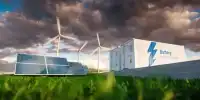Scientists are successful in turning carbon dioxide into liquid fuel
US researchers have discovered a new electrocatalyst that converts carbon dioxide (CO2) and water into ethanol with very high energy efficiency, high selectivity for the desired final product, and low cost. The secret is an electrified catalyst made from copper and carbon, which the researchers say can be powered using low-cost off-peak or renewable energy.
A research team, led by the U.S. Department of Energy’s (DOE) Argonne National Laboratory in collaboration with Northern Illinois University, has discovered a new electrocatalyst that converts carbon dioxide (CO2) and water into ethanol with very high energy efficiency, high selectivity for the desired final product and low cost. Ethanol is a particularly desirable commodity because it is an ingredient in nearly all U.S. gasoline and is widely used as an intermediate product in the chemical, pharmaceutical, and cosmetics industries. In the United States, there is a high demand for ethanol in the production of gasoline, and also in the chemical, pharmaceutical, and cosmetics industries.
Catalysts speed up chemical reactions and form the backbone of many industrial processes. For example, they are essential in transforming heavy oil into gasoline or jet fuel. Today, catalysts are involved in over 80 percent of all manufactured products.
“The process resulting from our catalyst would contribute to the circular carbon economy, which entails the reuse of carbon dioxide,” said Di-Jia Liu, senior chemist. This process would do so by electrochemically converting the CO2 emitted from industrial processes, such as fossil fuel power plants or alcohol fermentation plants, into valuable commodities at a reasonable cost. This new process would work by electrochemically converting the CO2 emitted from industrial processes, such as fossil fuel power plants, into liquid fuel.
Northern Illinois University professor and participating Argonne researcher Tao Xu says the new catalyst isn’t just a single stop that can produce ethanol—it’s the first step down a possibly long list of ways to turn carbon dioxide into other useful chemicals. The team’s catalyst consists of atomically dispersed copper on carbon-powder support. By an electrochemical reaction, this catalyst breaks down CO2 and water molecules and selectively reassembles the broken molecules into ethanol under an external electric field.
“With this research, we’ve discovered a new catalytic mechanism for converting carbon dioxide and water into ethanol,” said Tao Xu, a professor in physical chemistry and nanotechnology from Northern Illinois University. “The mechanism should also provide a foundation for the development of highly efficient electrocatalysts for carbon dioxide conversion to a vast array of value-added chemicals.”
Lowering the cost to begin breaking up the carbon dioxide means a variety of new processes could open up and become feasible. Because CO2 is a stable molecule, transforming it into a different molecule is normally energy-intensive and costly. However, according to Liu, “We could couple the electrochemical process of CO2-to-ethanol conversion using our catalyst to the electric grid and take advantage of the low-cost electricity available from renewable sources like solar and wind during off-peak hours.” The most immediate opportunities are to turn carbon dioxide into other hydrocarbons. If the process is efficient enough, it could even exceed the energy cost of mitigation of carbon dioxide by depositing it in bedrock, for example. Because the process runs at low temperatures and pressure, it can start and stop rapidly in response to the intermittent supply of renewable electricity.
“We have prepared several new catalysts using this approach and found that they are all highly efficient in converting CO2 to other hydrocarbons,” said Liu. “We plan to continue this research in collaboration with industry to advance this promising technology.”
Ethanol is blended into most American consumer gas products, and its source from waste corn is also an inefficient process. There’s an opportunity to lower the cost of ethanol used in these blends. All in all, this catalyst is an exciting tool that could have a domino effect on several different kinds of energy research.
















